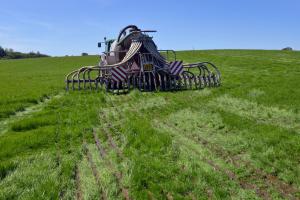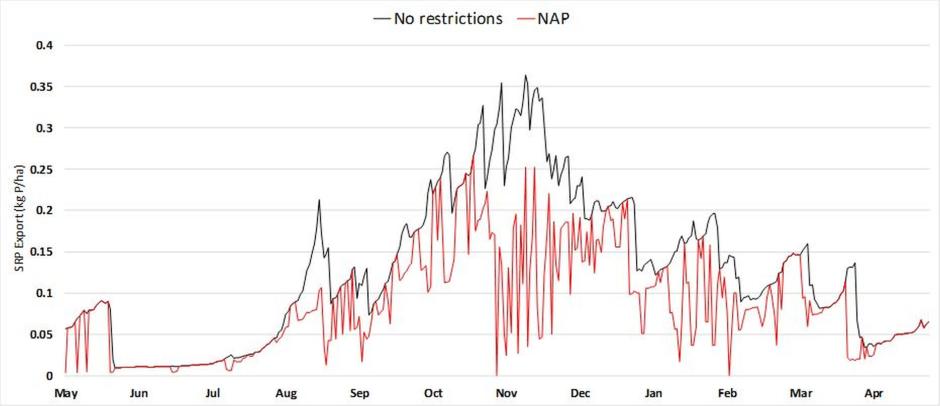Are the Regulations on Slurry Application Helping to Improve Water Quality?
Date published:
Slurry application is a key component of effective nutrient management on Northern Irish farms. However, it requires careful management to ensure it is applied in the right place at the right time so as to avoid losses to the environment. Through a DAERA funded project, AFBI evaluated the effectiveness of the current regulations controlling slurry applications on farms.

Background
Phosphorus (P) is the main nutrient of concern for freshwaters in Northern Ireland (NI), and since 2004 its use has been regulated under the EU Nitrates Directive (91/676/EEC), followed by the Phosphorus (Use in Agriculture) Regulations (Northern Ireland) in 2006. However it wasn’t until 2009, after the delivery of a capital grant aid scheme to support the construction of manure storage facilities, that the closed period for slurry application (15 October to the 31 of January) was introduced in NI.
As a result of the efforts of farmers, industry and government there has been a significant improvement in water quality across NI since the 1990’s. However, recent monitoring indicates that since 2012-13 this trend may be reversing. Currently, 69% of our rivers and 76% of our lake are impacted by P, with agriculture contributing 62% of the annual load to waterbodies with the remainder coming from Waste Water Treatment Plants (WWTP), septic tanks and industrial sources.
Phosphorus losses in runoff following slurry application to fields, makes a significant contribution to the annual P loading to rivers and lakes in NI. Slurry application is an inherently risky practice, especially in NI where there is a high frequency of rainfall and soils are wet for much of the year. When deciding to apply slurry on a specific day, farmers will obviously be considering how much free capacity is left in their slurry stores, how much longer their livestock will need to be housed, and when the next opportunity to apply slurry may arise, but they need to balance these considerations against the risk of P loss in runoff, whether or not soil and rainfall forecast are suitable for slurry spreading, and also whether or not slurry nutrients will be available for crop up take if applied at this time. In relation to this final consideration, it is worth noting that more than £10 million worth of potash (K2O) is lost each year in runoff from farmland, and that a sizeable proportion of this potash is likely to come from slurry.
AFBI Research
Demonstrating the benefits of the current restriction on slurry spreading and in particular the closed period, is challenging. However, it is important for both farmers and policy makers to have confidence that their efforts are having a positive impact on water quality. To achieve this AFBI has applied the SurPhos (Surface runoff model for Phosphorus) model, to simulate the amount of P loss on each day of the year depending on rainfall and soil moisture conditions. Phosphorus can take a range of forms, with soluble reactive P (SRP) the form which has the most negative impact on waterways.

Using an historical rainfall, runoff and soil moisture dataset from the AFBI Hillsborough farm, the model was used to predict, over a 4-year period, the daily loss of SRP, when slurry is applied at a rate of 30 m3 per ha to a soil type that is representative of 54% of NI’s soils. The results in Figure 1 shows the difference between the current Nutrient Action Programme (NAP) regulations (red lines) and a scenario where there are no restrictions on slurry spreading (grey lines). On average the NAP regulations resulted in a 32% reduction in SRP lost in runoff over the full year, with reductions of 24% and 39% in the open and closed period respectively. The results also highlighted the importance of targeting applications at drier soils, with an 87% reduction in SRP loss when applications were targeted on well drained soils rather than poorly drained soils. Due to the high risk nature of slurry applications in February, the maximum application rates in the NAP regulations was reduced in 2019 from 50 m3 per ha to 30 m3 per ha. The results from the SurPhos model suggest that this would produce a 49% reduction in SRP being lost in runoff during the month of February.
Changes to the Closed Period?
The results from the SurPhos model demonstrate that the current closed period is effective in reducing the loss of P to water in NI. If the ban on spreading during the closed period was lifted and slurry application was permitted on the same basis as in the current open period, SRP export would be 33% higher compared to that in the current open period. According to the model, extending the closed period to include the entirety of October and February, would result in a 13% reduction in SRP loss over the open period. However, this change does not factor in the knock-on impact on slurry storage capacity and the greater volume of slurry that would have to be spread between 1 March and the 30 September. On the other hand, a shortening of the closed period to allow slurry spreading in January would result in a 4% increase in SRP export, but would necessitate a tightening of the regulations regarding soil moisture conditions under which slurry application would be allowed. It is likely that if these tighter regulations were also applied during the remainder of the open period, the overall impact would be fewer days available for slurry spreading between 1st January and 15th October than are available in the current open period.
Conclusion
The results of the Surphos modelling suggest that the current Nutrient Action Programme regulations controlling slurry application to soils, is helping to reduce the loss of P from agriculture to aquatic ecosystems. Further improvement could be achieved if farmers have access to high resolution rainfall and soil moisture data so as to target application at the right place at the right time. In particular investment in rainfall and soil moisture data is required if changes to the current closed period are proposed.
Notes to editors:
AFBI is an arms-length body of DAERA delivering research and development, diagnostic and analytical testing, emergency response capability and expert scientific advice for DAERA and other government departments, public bodies and commercial companies in Northern Ireland, and further afield.AFBI’s Vision is “Advancing the Local and Global Agri-Food Sectors Through Scientific Excellence”.AFBI’s core areas:Leading improvements in the agri-food industry;Protecting animal, plant and human health;Enhancing the natural and marine environment.